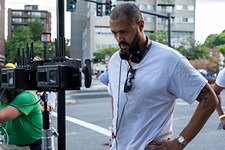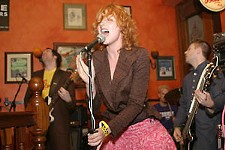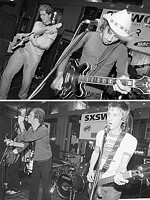Cradle Will Rock
Tim Robbins' historical drama mixes true events and characters from Roosevelt's New Deal pet, the Federal Theatre Project, and intersperses them with fictionalized elements with mixed results.
Reviewed by Jerry Renshaw, Fri., July 27, 2001
D: Tim Robbins (1999); with Rubén Blades, Susan Sarandon, Bill Murray, John Cusack, Joan Cusack, John Carpenter, Hank Azaria, Cary Elwes, Philip Baker Hall, John Turturro, Jack Black.
In the 1930s, Roosevelt's New Deal put its weight behind the Federal Theatre Project, which provided government support for theatre activities in towns small and large across the country. Robbins' film is a historical drama that mixes true events and characters from the time with fictionalized elements; Cradle Will Rock yields mixed results. Marc Blitzstein (Azaria) is a playwright who is working on a pro-union, leftist play titled The Cradle Will Rock, which Orson Welles' Mercury Theatre is struggling to bring to the stage. Congressman Dies' House Un-American Activities Committee (HUAC) has other ideas, though; in a climate where the powers that be are fearful of Communist agitation and labor unrest, they shut the funding off for the production. Joan Cusack and Bill Murray play two staunch anti-Red Federal Theatre employees who consider it their patriotic duty to testify before HUAC. Meanwhile, Nelson Rockefeller (John Cusack) fancies himself to be a patron of the arts, buying paintings from Mussolini's liaison Margherita Sarfatti (Sarandon) while simultaneously commissioning Diego Rivera (Blades) to do an enormous mural for Rockefeller Center. Sparks fly when Rivera's final product depicts a Leninist agitprop tableau of class struggle and union activism. Once the work is completed, Rockefeller has maintenance men with jackhammers destroy the mural. Robbins puts the narrative together in an almost Altman-like fashion, as an ambitious collection of vignettes and subplots that add up by film's end. Unfortunately, it doesn't quite work. McFayden portrays Welles as a talented but insufferable blowhard opposite Houseman's (Elwes) gasbag; undoubtedly that's much what the two men were like, but Robbins' direction paints them nearly as cartoon characters. Interestingly, the story has Welles traveling in much the same circles as William Randolph Hearst (Carpenter, looking very creepy) -- two men who were unknowingly on a collision course with each other. The play-within-the-movie is a fairly muddled mess of rotten songs and pro-labor propaganda (Robbins himself was once in a production of the same play), as fits the time. Sarandon's performance often doesn't work, with her accent wavering between Italian and maybe Russian much of the time. Perhaps the film's biggest flaws, though, lie in its tidy sentimentality (with a New York that's much cleaner than the 1930s version must have been) and the heavy hand of Robbins' own politics smudging everything up. One scene has Robbins cutting back and forth from Rockefeller, Hearst, and several others at a costume party dressed as 18th-century aristocrats to the hardscrabble theatre company for a painfully obvious metaphor. That same heavy hand turns the film's ending into a club with which to hit the viewer over the head. Having said that, Cradle is certainly interesting because of the historical context and its portrayal of a time when the Left had a chance at really making a difference in American society. Despite some bad casting and/or direction at times, there are some very good performances to be seen here. Murray is excellent as a broken-down vaudevillian hired to coach two hopelessly untalented jerks (Black and Hall) in the stage art of ventriloquism; after his testimony before the Dies Committee, he has second thoughts and his guilt catches up with him. Cherry Jones is also great as the fiery Hallie Flanagan, a manager of the FTP brought before the Dies Committee, and Blades is compelling in his portrayal of Diego Rivera (though Frieda Kahlo's character doesn't get much screen time). Cradle doesn't always succeed, but Robbins' film intelligently and passionately goes a long way toward bringing the political complexities of those times to life, even if in a somewhat one-sided way.










